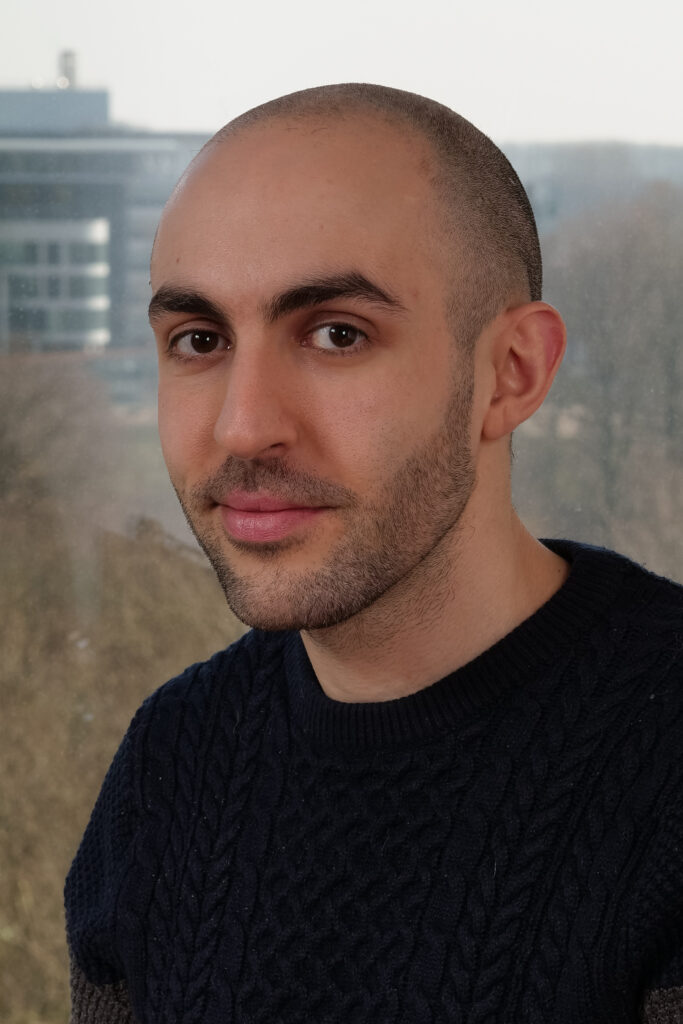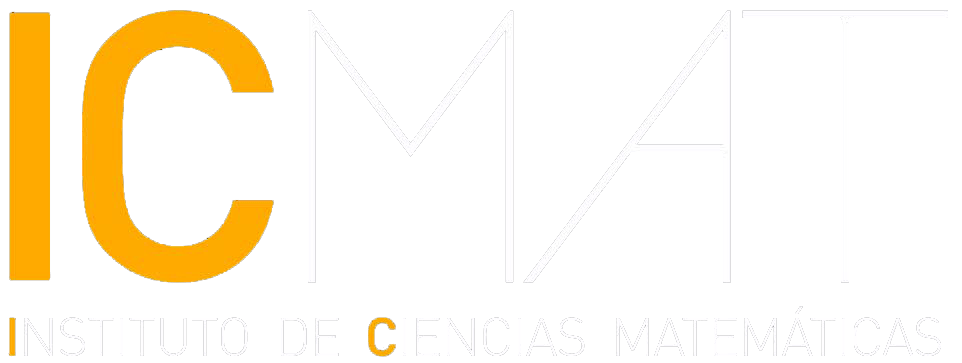
Álvaro del Pino is a member of the Utrecht University in the Netherlands. He obtained his Ph.D. in 2017 under the supervision of Francisco Presas (ICMAT-CSIC) at ICMAT.
This week, from June 17 to 21, the Summer School on h-principle is being held at ICMAT, a training meeting on a very active area in current geometry research: the h-principle. The program includes three introductory mini-courses and seven advanced lectures, given by some of the leading international experts in this field, which makes it possible to tackle geometric problems with algebraic tools. We spoke with Álvaro del Pino, professor at Universiteit Utrecht in the Netherlands, expert in the use of differential topology techniques to study geometric structures and co-organizer of the event, about this fascinating topic.
Ágata Timón G Longoria (ICMAT).
Question: We could say that the motivation of the h-principle is, in general, to circumvent difficulties that appear when studying geometric problems, can you explain to us the underlying idea of this technique?
Answer: The goal in h-principle is to reduce geometric problems to the so-called homotopy theory. The idea is, in general, the following: one wants to study a certain geometric problem that involves taking derivatives. Sometimes, it is possible to relate this to the study of a second problem that does not require taking derivatives at all. Proving that both problems are equivalent is what we call h-principle. Once this has been proved, we can use the so-called homotopy theory – algebraic techniques to study the shape that spaces have – to solve the second problem. Thus, we get to pass the buck to someone working in homotopy theory. Of course, I’m exaggerating a bit: when we have concrete applications in mind, we don’t mind getting our hands dirty and solving the corresponding homotopy problem.
Q: Could you present any examples where this tool has been successfully used in research?
A: These ideas are incredibly general, so they are relevant in any area of geometry and, nowadays, also in partial equations. At the same time, there is a lot of field to explore: there are a few geometries where the h-principle has been used a lot – for example, contact geometry, symplectic geometry, in foliations or in positive scalar curvature metrics – but for most geometries we know very little. This makes it an attractive field for young people, because there is a lot of activity.
Q: When did it start to be used, and what was the initial motivation?
A: The term “h-principle” dates from the late 1960s, so we can say that this is a relatively young area. However, in the 1930s the first results that we can consider as “proto h-principle” already appear. Since the end of the 19th century, the concept of “variety”, which is basically a locally Euclidean space, had been consolidating. That is, spaces that resemble the real straight line, the plane, or the 3-dimensional space we know well; the sphere, the doughnut surface, the circle, are examples. A key question at that time was to understand whether it is possible to put some varieties into others, and in how many ways. For example, how many ways can you put a circle on the surface of a donut, or on the surface of the sphere?
Placing varieties is much more interesting when we ask that they not be wrinkled, spiky, or broken. Mathematically, we then say that we have placed the variety in an immersed form. If, additionally, we ask that the variety be placed without self-intersecting – without cutting itself – we say that it is an embedding. For example, the usual sphere in three-dimensional space, as we usually visualize it, is embedded; we have no self-intersections in this case. However, if we take the north pole and push it down, making it cross the south pole, the sphere self-intersects into a circle of double points and we would get a kind of pillow, which is an immersion, but not an embedding.
The first “proto h-principle” theorems are due to Hassler Whitney in the 1930s. Among other things, Whitney proved that every variety can be put into a Euclidean space of sufficiently large dimension and, soon after, he was able to classify all immersions of the circle in the plane. These results were followed by a host of advances in the same spirit. The difficulty in this type of problem is that constructing immersions requires controlling derivatives: to put one manifold into another is basically to define a function, and to do so without wrinkles or peaks requires constructing a function whose derivative is “good”. The classical era in the study of immersions thus culminates in the late 1950s, when Stephen Smale and Morris Hirsch prove that classifying immersions is equivalent to classifying tangent monomorphisms, a problem that does not involve derivatives at all.
This result is one of the pillars of the h-principle. The other is John Nash’s work on isometric embeddings, also in the 1950s. However, it is not until the late 1960s, when Gromov generalizes these ideas to other geometries, that the h-principle is consolidated as a subject in its own right.
“Mikhail Gromov initiated the modern h-principle, which basically aims to classify, homotopically, all geometric structures in a given variety”
Q: And, how did the idea evolve, from that more modern perspective?
A: In the late 60s and early 70s of the last century, Mikhail Gromov initiated the modern h-principle, which basically aims to classify, homotopically, all geometric structures in a given variety. That is, what Smale and Hirsch had done for immersions, do for other geometries in which the derivatives of the maps satisfy some additional constraint. This applies to any area within differential geometry, hence to Riemannian, symplectic, complex and contact geometries, foliations… Gromov classified in 1969 many geometries into open varieties -varieties that have a part that “goes to infinity”- with a theorem that generalizes what Hirsch and Smale had done for immersions. In the 1970s, with entirely new ideas, William Thurston classified foliations into every variety, even closed, “without infinity”. In 1989, Yakov Eliashberg classified the so-called overtwisted contact structures. From the 1980s to the last decade of the 21st century, the work of Gromov, Eliashberg, Kai Cieliebak and Emmy Murphy (and others) has explained how to classify smooth affine complex varieties, which is incredibly surprising, since one would a priori think that they are extremely rigid objects governed by algebraic geometry.
Q: You have also worked successfully on these topics in Spain, haven’t you?
A: Yes, indeed. The group led by Francisco Presas (ICMAT-CSIC), of which I am a member, has proved many similar classification results for other geometric structures in recent years, especially for non-integrable distributions. Fran, Eva Miranda (Universitat Politècnica de Catalunya and Centre de Recerca Matemàtica), Daniel Peralta (ICMAT-CSIC), and Robert Cardona (Universitat de Barcelona) have used h-principle ideas to construct dynamical systems that have certain computational properties. Others, including Peralta himself, Daniel Faraco (ICMAT-UAM), Francisco Gancedo (University of Seville) and Francisco José Mengual (Max Planck Institute for Mathematics, Germany), have used the h-principle to construct certain types of solutions – called low regularity – of the equations describing the motion of fluids, which is a topic of enormous importance today in the field of partial derivative equations.
“The group led by Francisco Presas (ICMAT-CSIC), of which I am a member, has proved many similar classification results for other geometric structures in recent years.”
Q: Many of the people you mentioned participate in the School.
A: All the speakers at the conference are people who actively work on h-principles, including Yakov Eliashberg, one of the fathers of this subject together with Gromov, particularly with regard to the use of the h-principle in contact geometry and symplectics. The school is aimed primarily at doctoral students and postdocs working in the area of differential geometry. Some come from areas where the h-principle is already a key technique, but others come from disciplines where we do not yet understand well what role this tool plays. In that sense, it will be a great opportunity for a wide range of people to interact.
Summer School on h-principle
The Summer School takes place from June 17-21 at ICMAT and includes fundamental introductory courses on some of the main techniques of the h-principle (holonomic approximation, convex integration, wrinkling), as well as on recent applications to geometry and topology. The following introductory mini-courses will be given:
- The holonomic approximation lemma, by Daniel Alvarez Gavela (Massachusetts Institute of Technology, MIT).
- Preliminaries in the philosophy of the h-principle , by Alvaro del Pino (Universiteit Utrecht)
- Convex integration, by Mélanie Theillière (Université de Luxembourg)
In addition, the following talks and advanced mini-courses will be offered:
- Discretizing symplectic topology, by Mélanie Bertelson (Université Libre de Bruxelles).
- Wrinkling and generalized Morse functions, by Kai Cieliebak (Universität Augsburg)
- Flexible and Rigid facets of Mathematics, by Yakov Eliashberg (Stanford University)
- Delooping and h-principles, by Alexander Kupers (University of Toronto)
- Simplifying (and complicating) Weinstein presentations, by Oleg Lazarev (UMass Boston)
- The h-principle in the homotopy theory of foliations, by Gaël Meigniez (Aix-Marseille)
- The h-principle and Reeb/Beltrami embeddings, by Robert Cardona (Universitat de Barcelona)
The organizing committee of the School is formed by Daniel Álvarez Gavela, Álvaro del Pino and Mélanie Theillière and is funded by ICMAT, Universiteit Utrecht, MIT and Université de Luxembourg.
Álvaro del Pino
Alvaro del Pino is a researcher at the Universiteit Utrecht in the Netherlands. Before coming to the Netherlands, he was part of ICMAT, where he obtained his PhD under the supervision of Francisco Presas (ICMAT-CSIC) in June 2017. Then, his first contract in Utrecht was as a postdoctoral researcher within the NWO Vici project led by Marius Crainic. In 2018, he himself obtained a NWO fellowship, of the Veni type. In 2024, he will start a NWO Vidi project. In 2022, he was one of the recipients of the Lichnerowicz Prize in Poisson Geometry.
This content has been automatically translated. The original text may differ slightly.
